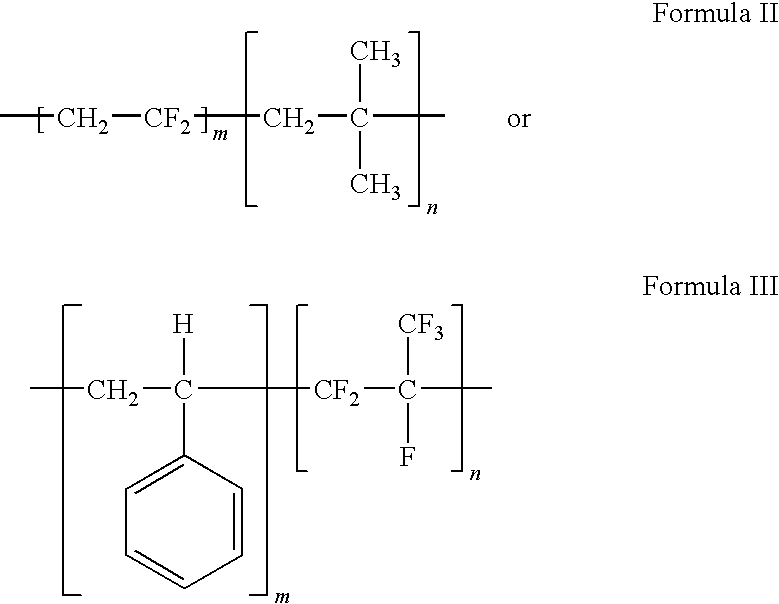Polymers of fluorinated monomers and hydrocarbon monomers
a technology of fluorinated monomers and hydrocarbon monomers, which is applied in the field of polymer materials, can solve the problems of stent thrombosis, chronic issues of restnosis, and inability to withstand amorphous coating materials, and achieves the effect of reducing the number of stents
- Summary
- Abstract
- Description
- Claims
- Application Information
AI Technical Summary
Benefits of technology
Problems solved by technology
Method used
Image
Examples
example 1
Synthesis of poly(block-vinylidene fluoride-co-block-isobutylene)
[0039]Fluoropolymers are typically synthesized by free radical polymerization, using suspension or emulsion techniques, while polyisobutylene is typically produced via cationic polymerization methods (see G. Odian, Principles of Polymerization, 3rd Ed., John Wiley & Sons, NY, 1991). However, fluoropolymers can also be synthesized by atom transfer radical polymerization (ATRP) using iodine or bromine functional initiators. These polymerizations result in PVDF with terminal iodine or bromine groups. These endgroups can then be used directly, or functionalized, to serve as carbocationic initiators for isobutylene. A block co-polymer can be made by first synthesizing a bromo-terminated poly(vinylidene fluoride) via ATRP techniques (see Z. Zhang, et al. “Synthesis of fluorine-containing block copolymers via ATRP 1. Synthesis and characterization of PSt-PVDF-PSt triblock copolymers”, Polymer (40) (1999) 1341-1345). The resul...
example 2
Synthesis of poly(vinylidene fluoride-co-styrene)
[0040]Both monomers are amenable to free radical polymerization. This polymerization can be via suspension or emulsion polymerization techniques. Useful initiators are peroxides, organic soluble peroxides, persulfate compounds, and azo compounds. Redox systems such as compounds containing ferrous, sulfite, or bisulfite ions can be used to produce desirable initiation rates at low temperatures. One useful route is suspension polymerization in an autoclave. A vinylidene fluoride / styrene copolymer dispersion can be prepared having a composition of 90% vinylidene fluoride and 10% styrene by weight. To a 10 gallon glass-lined autoclave is added 5 gallons of deionized water, and charged with 2.2 kg of vinylidene fluoride (VDF) and 0.24 kg of styrene. After sparging with nitrogen to remove all oxygen, and with rapid stirring, a solution of 20 gm of a 70% solution of tertiary butyl hydroperoxide (TBHP) that is diluted to 100 ml with deionized...
example 3
Coating a Stent with the Composition of Example 2
[0041]A composition can be prepared by mixing the following components:
[0042](a) about 2.0% (w / w) of poly(butyl methacrylate) (PBMA), and
[0043](b) the balance a 50 / 50 (w / w) blend of acetone and cyclohexanone. The composition can be applied onto the surface of bare 12 mm small VISION™ stent (Guidant Corp.). The coating can be sprayed and dried to form a primer layer. A spray coater can be used having a 0.014 round nozzle maintained at ambient temperature with a feed pressure 2.5 psi (0.17 atm) and an atomization pressure of about 15 psi (1.02 atm). About 20 μg of the coating can be applied at per one spray pass. About 80 μg of wet coating can be applied, and the stent can be dried for about 10 seconds in a flowing air stream at about 50° C. between the spray passes. The stents can be baked at about 80° C. for about one hour, yielding a drug reservoir layer composed of approximately 60 μg of PBMA.
A second composition can be prepared by ...
PUM
 Login to View More
Login to View More Abstract
Description
Claims
Application Information
 Login to View More
Login to View More - R&D
- Intellectual Property
- Life Sciences
- Materials
- Tech Scout
- Unparalleled Data Quality
- Higher Quality Content
- 60% Fewer Hallucinations
Browse by: Latest US Patents, China's latest patents, Technical Efficacy Thesaurus, Application Domain, Technology Topic, Popular Technical Reports.
© 2025 PatSnap. All rights reserved.Legal|Privacy policy|Modern Slavery Act Transparency Statement|Sitemap|About US| Contact US: help@patsnap.com



